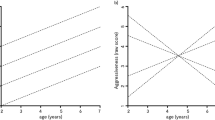Abstract
The genetics of social behavior presents special difficulties because the phenotype is the product of an interaction between two or more individuals. Social interactions are of two kinds: (1) cooperative, in which the probabilities of transmission of the genes of all participants are similarly affected by the outcome, and (2) agonistic, in which the probabilities for the participants are affected in opposite directions. The latter are of particular interest for evolutionary theory. Three major types of designs for measuring social behavior in genetic experiments are available: (1) homogeneous sets, (2) standard tester and (3) tester panel representing a reference population. The advantages and limitations of each method are discussed. Important areas for future development include the relationship of genetic and experiential factors in early life to social status as an adult and the extension of the genetic analysis of social behavior to natural populations.
Similar content being viewed by others
References
Allee, W. C. (1938).The Social Life of Animals, Norton, New York.
Ayala, F. J. (1972). Frequency-dependent mating advantage inDrosophila.Behav. Genet. 2:85–92.
Bruell, J. H. (1970). Behavioral population genetics and wildMus musculus. In Lindzey, G., and Thiessen, D. D. (eds.),Contributions to Behavior-Genetic Analysis: The Mouse as a Prototype. Appleton-Century-Crofts, New York, pp. 261–291.
Cairns, R. B. (1976). The ontogeny and phylogeny of social interactions. In Hahn, M. E., and Simmel, E. C. (eds.),Communicative Behavior and Evolution, Academic Press, New York, pp. 115–139.
Calhoun, J. B. (1962). A “behavioral sink”. In Bliss, E. L. (ed.),Roots of Behavior, Harper, New York, pp. 295–315.
Christian, J. J. (1961). Phenomena associated with population density.Proc. Natl. Acad. Sci. 47:428–449.
Christian, J. J. (1970). Social subordination, population density, and mammalian evolution.Science 168:84–90.
Craig, J. V., Ortman, L. L., and Guhl, A. M. (1965). Genetic selection for social dominance ability in chickens.Anim. Behav. 13:114–131.
DeFries, J. C., and McClearn, G. E. (1970). Social dominance and Darwinian fitness in the laboratory mouse.Am. Naturalist 104:408–411.
Doner, R. D., Inman, C., and Davis, R. T. (1952). Competitive behavior between inbred strains of mice.Proc. S. Dakota Acad. Sci. 31:172–176.
Falconer, D. S. (1960).Quantitative Genetics, Ronald Press, New York.
Fuller, J. L., and Clark, L. D. (1968). Genotype and behavioral vulnerability to isolation in dogs.J. Comp. Physiol. Psychol. 66:151–156.
Ginsburg, B. E., and Allee, W. C. (1942). Some effects of conditioning on social dominance and subordination in inbred strains of mice.Physiol. Zool. 15:485–506.
Hahn, M. E. (1971). Social relationships and their development in two strains ofMus musculus.Diss. Abst. Int. 32:(1-B):585.
Hahn, M. E., Haber, S. B., and Fuller, J. L. (1973). Differential agonistic behavior in three lines of mice selected for brain weight.Physiol. Behav. 10:759–762.
Harlow, H. F., and Harlow, M. K. (1966). Learning to love.Am. Scientist 54:244–272.
Henderson, N. D. (1970). Genetic influences on the behavior of mice can be obscured by laboratory rearing.J. Comp. Physiol. Psychol. 72:505–511.
Hinde, R. A. (1956). The biological significance of the territories of birds.Ibis 98:340–369.
Lagerspetz, K., and Raija, M. (1965). Simulation experiments on stimuli eliciting aggressive behavior in mice.Reports of the Psychology Institute, University of Turku, No. 13.
Lagerspetz, K., and Seija, T. (1967). Maturation of aggressive behavior in young mice.Reports from the Institute of Psychology, University of Turku, No. 28.
Manning, A. (1963). Selection of mating speed inDrosophila melanogaster based on behaviour of one sex.Anim. Behav. 11:116–120.
Marler, P. H., and Hamilton, W. J. (1966).Mechanisms of Amimal Behavior, Wiley, New York.
McBride, G. (1958). The measurement of aggressiveness in the domestic hen.Anim. Behav. 6:87–91.
McGill, T. E. (1970). Genetic analysis of male sexual behavior. In Lindzey, G., and Thiessen, D. D. (eds.),Contributions to Behavior-Genetic Analysis: The Mouse as a Prototype, Appleton-Century-Crofts, New York, pp. 57–88.
Parsons, P. A. (1967).The Genetic Analysis of Behaviour, Methuen, London.
Pawlowski, A. A., and Scott, J. P. (1956). Heredity differences in the development of dominance in litters of puppies.J. Comp. Physiol. Psychol. 49:353–358.
Ropartz, P. (1968). The relation between olfactory stimulation and aggressive behaviour in mice.Anim. Behav. 16:97–100.
Scott, J. P. (1958).Animal Behavior, University of Chicago Press, Chicago.
Scott, J. P. (1966). Agonistic behavior of mice and rats: A review.Am. Zoologist 6:683–701.
Scott, J. P., and Fuller, J. L. (1965).Genetics and the Social Behavior of the Dog, University of Chicago Press, Chicago.
Selander, R. K., and Yang, S. Y. (1970). Biochemical genetics and behavior in wild house mouse populations. In Lindzey, G., and Thiessen, D. D. (eds.),Contributions to Behavior-Genetic Analysis: The Mouse as a Prototype, Appleton-Century-Crofts, New York, pp. 293–334.
Southwick, C. H., and Clark, L. H. (1968). Interstrain differences in aggressive behavior and exploratory activity of inbred mice.Commun. Behav. Biol. A(i):49–59.
Stevens, S. S. (1951). Mathematics, measurement and psychophysics. In Stevens, S. S. (ed.),Handbook of Experimental Psychology, Wiley, New York, pp. 1–49.
Thiessen, D. D. (1972). A move toward species-specific analyses in behavior genetics.Behav. Genet. 2:115–126.
Tinbergen, N. (1948). Social releasers and the experimental method required for their study.Wilson Bull. 60:6–52.
Uhrich, J. (1938). The social hierarchy in albino mice.J Comp. Physiol. Psychol. 25:373–413.
Ulrich, R. E., Hutchinson, R. R., and Azrin, N. H. (1965). Pain elicited aggression.Psychol. Rec. 15:111–126.
Vale, J. R., and Ray, D. (1972). A diallel analysis of male mouse sex behavior.Behav. Genet. 2:199–209.
Willems, E. P. (1969). Planning a rationale for naturalistic research. In Willems, E. P., and Rausch, H. L. (eds.),Naturalistic Viewpoints in Psychological Research, Holt, Rinehart and Winston, New York, pp. 44–71.
Wood-Gush, D. M. G. (1958). Genetic and experimental factors affecting the libido of cockerels.Proc. Roy. Soc. Edinburgh 27:6–7.
Wynne-Edwards, V. C. (1962).Animal Dispersion in Relation to Social Behavior, Hafner, New York.
Author information
Authors and Affiliations
Additional information
Supported by Grant GB 24827 from the National Science Foundation and Grants MH 22005 and MH 13058 from the National Institute of Mental Health.
Rights and permissions
About this article
Cite this article
Fuller, J.L., Hahn, M.E. Issues in the genetics of social behavior. Behav Genet 6, 391–406 (1976). https://doi.org/10.1007/BF01065697
Received:
Issue Date:
DOI: https://doi.org/10.1007/BF01065697




